Sat 4 Aug 2012
Mike Nevins on THE BOWSTRING MURDERS, ELLERY QUEEN and BOSTON BLACKIE.
Posted by Steve under Columns , Old Time Radio , Reviews , TV mysteries[11] Comments
by Francis M. Nevins
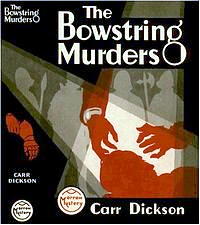
The golden oldie I picked to reread last month was The Bowstring Murders (1933), the only John Dickson Carr novel ever published under the byline Carr Dickson. I wouldn’t rank it among Carr’s top ten or even the top thirty but thought it was on the whole satisfactory, taking place almost entirely in an eerie 15th-century Suffolk castle full of the Poe-like atmosphere that the young Carr loved to generate.
Is it truly golden? According to Doug Greene’s biography The Man Who Explained Miracles (1995), Carr wrote Bowstring in New York “at white-hot speed†after his English wife Clarice discovered she was pregnant and also in order to finance a long visit to England for the family.
Greene calls the novel “badly flawed .. John Gaunt [the criminologist who solves the murders] is sharply drawn, but the plot…is unconvincing.†He correctly describes the explanation of the seemingly impossible murder of Lord Rayle as “a creative variation of the solution in [Carr’s first novel] It Walks by Night…â€
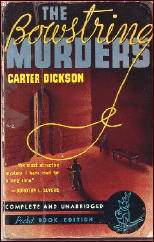
He was surprised by “how many mistakes Carr makes about England†but the ones he cites strike me as trivial: the servants “all speak a strange sort of Cockney†and after Lord Rayle’s murder the Bowstring footman fails to address the dead man’s son and successor to the title as “Your Lordship.â€
Greene also mentions “some sloppy lines†in the book but quotes only one, from Chapter 12: “With one gloved hand, he dived behind the body.†Does that sentence rise to the lofty heights of an Avalloneism? Personally, I don’t think so.
What bothered me most about the plot (am I giving away too much here?) is that, in order for the crucial gimmick to work, a cowled “white-wool monk’s robe†of the sort which the “more than half-cracked†Lord Rayle wore while wandering around Bowstring must be concealed by the murderer in an ordinary briefcase.
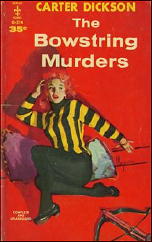
S. T. Joshi in John Dickson Carr: A Critical Study (1990), is no fonder of The Bowstring Murders than Doug Greene. He calls the novel a “confused and shoddily written work†and both the book and its protagonist “spectacular failures.†(Greene, as we’ve seen, disagrees with Joshi about John Gaunt.)
Joshi’s main complaint is that “the solution depends vitally upon our knowing the exact plan of the house, which is not provided.†Obviously there was no such plan in whatever edition Joshi read, and there’s none in the only edition I have (Berkley pb #G-214, 1959).
But there are several references to the local inspector making a drawing of Bowstring Castle, and I have a hunch that the sketch does appear in the original hardcover edition. If someone reading this column can tell me whether I’m right or wrong, please speak up.
If anyone decides to read the novel on the strength of this discussion, they should first go here and download the detailed diagram of the castle that Wyatt James, 1944-2006 (known to Internet mystery fandom as Grobius Shortling) kindly prepared for Carr fans who don’t have a copy of that first edition. And, if my hunch is wrong, even for those who do.
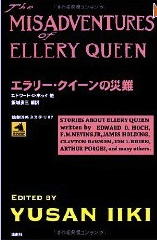
In my mailbox recently was a book that was sent from Japan but has an English as well as a Japanese title: The Misadventures of Ellery Queen. This 400-page anthology, edited by Yusan Iiki and published by Ronsosha Ltd. Of Tokyo, brings together a huge assortment of parodies and pastiches of the immortal EQ, written by such authors as Jon Breen, Ed Hoch, James Holding, Josh Pachter, Clayton Rawson and, if I may be so immodest as to say it, me. (Anyone remember “Open Letter to Survivors�)
The most recent story in the volume, and probably the finest Queen pastiche ever written, is “The Book Case†(EQMM, May 2007) by Dale Andrews and Kurt Sercu, in which Ellery at age 100 proves that his body may be feeble but his mind is sharp as ever.
Years ago Josh Pachter put together an anthology, also called The Misadventures of Ellery Queen, but could never find a publisher for it. The appearance of this new volume, coupled with the failure of Pachter’s book to find a home, provides an excellent demonstration of how tall Queen still stands in Japan and how deeply he’s sunk into oblivion almost everywhere else.
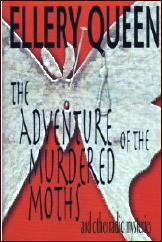
Thinking about the role of genetics in mystery fiction, we at once conjure up the DNA testing scenes in countless TV forensic series. But the subject has also figured in the Golden Age of the whodunit. In the 60-minute radio drama “The Missing Child†(The Adventures of Ellery Queen, CBS, November 26, 1939).
Ellery’s solution hinges on his assertion that it’s impossible for two blue-eyed parents to have a brown-eyed child. That was a common belief at the time, and was also crucial to the solution in an Agatha Christie story of the same decade (“The House at Shiraz,†collected in Mr. Parker Pyne, Detective, 1934).
But it’s flatly not true, as Fred Dannay and Manny Lee must have discovered sometime in the ten or eleven years following broadcast of the drama. How do I know? Because the fact of its falsity is central to one of the later EQ short stories, “The Witch of Times Square†(This Week, November 5, 1950; collected in QBI: Queen’s Bureau of Investigation, 1955).
Genetics mistake and all, the original script is included in that indispensable collection of Queen radio plays The Adventure of the Murdered Moths (Crippen & Landru, 2005).
In a column posted back in 2006 I waxed nostalgic for a paragraph or two about Boston Blackie (1951-53, 58 episodes), starring Kent Taylor in perhaps the earliest and certainly one of the finest action-detective TV series, most episodes featuring one or more elaborate chase-and-fight sequences shot on Los Angeles streets and locations.

Eighteen of the 26 segments that made up the first season were directed by Paul Landres (1912-2001), whose action scenes, brought to life by master stuntmen Troy Melton and Bill Catching, were of eye-popping visual quality, especially considering that each episode was shot in two or at most three days.
Until recently it’s been next to impossible to find decent VHS or DVD copies of Blackie segments, all of which have long been in the public domain. Which is why I was delighted to discover recently that at least twenty episodes are now accessible on YouTube — and that many of them were digitally restored last year.
I especially recommend the earliest segments like “Phone Booth Murder†(#2), “Blind Beggar Murder†(#5), “The Cop Killer†(#6), and “Scar Hand†(#11), all directed by Paul, whom I met when he was in his mid-eighties and who was the subject of a book of mine that came out about a year before he died.
Paul would have been 100 this month, and to celebrate his centenary I’ve prepared a DVD tribute that will be presented at the Mid Atlantic Nostalgia Convention in Hunt Valley, Maryland on August 11.
In one of the tapes I made with Paul he vividly described an accident that took place while he was shooting the climax of “Phone Booth Murder.†His description is now preserved on my DVD, accompanied by the climactic sequence itself.
https://www.youtube.com/watch?v=uJ6voB6ADfE
If any readers of this column check out this episode and are interested in what went wrong and how Paul responded to the crisis, I’ll include his comments in my September column.
August 4th, 2012 at 7:48 pm
I wish I could say I was impressed with the Phone Booth Murder as you are, Mike. It was fun to watch, but all in all, I’ll probably pass on the others.
The action scenes were fine, though, and I could see several places where something could go wrong. Do tell us more.
August 4th, 2012 at 7:54 pm
For more on the Japanese language edition of Ellery Queen pastiches, go here:
http://somethingisgoingtohappen.net/2012/06/13/the-misadventures-of-ellery-queen-by-dale-c-andrews/
Among other things, Dale C. Andrews, author of one the stories included, talks about the difference between a parody and a pastiche, and at last I have a definition of the latter I can live with.
August 4th, 2012 at 8:07 pm
“Avalloneism”
I love it.
August 4th, 2012 at 9:44 pm
Jerry
I have a post coming up full of Avalloneisms, ones I haven’t seen before. They’re magnificent!
August 4th, 2012 at 9:45 pm
Shameless plug for my own review of The Misadventures of Ellery Queen (http://ho-lingnojikenbo.blogspot.jp/2012/07/all-queens-men.html). Though to be honest, I think this is pretty much the only English language review of the volume at the moment, as there are few bloggers (who blog in English) who focus on Japanese mystery releases… (And even fewer who handle Japanese translations of non-Japanese stories…)
August 5th, 2012 at 2:09 am
Ho-Ling
Thanks for the link. You did a great job discussing most (all?) of the stories. If you didn’t cover them all, you’ve certainly given me a fine idea of what the book is like. It sounds wonderful. I know I’ll never get around to being able to read Japanese, so all I can do is hope that someone will put together a collection of the very same stories as they appeared in English. It could be done! (If I understood your review correctly, only one of them was written first in Japanese.)
— Steve
August 5th, 2012 at 4:49 pm
Mike, I am not as big of fan of BOSTON BLACKIE TV series as you, but I am interested in reading more about what went on during the making of it.
August 6th, 2012 at 7:25 am
I checked my Morrow hardcover edition of The Bowstring Murders (1st edition, 2nd printing). No maps or floorplans, I’m afraid, but the plot certainly would have benefited from one, as you pointed out.
Best,
John
August 6th, 2012 at 11:10 am
Thanks, John. Looks like the one that Wyatt James put together that Mike linked to is all there is.
August 6th, 2012 at 7:23 pm
I’ve read a few of the EQ pastiches and parodies in magazines and anthologies.
Would love to read a whole book of them (in English).
Had no idea that this anthology existed.
Some of the pastiches are indeed first rate detective tales in their own right.
Thank you very much for such and informative article.
August 11th, 2012 at 4:45 pm
I remember watching and enjoying “Boston Blackie” when I was a kid. Here in the Philadelphia area it ran on a weeknight (Tuesday, I *think*) either from 7 to 7:30 or from 7:30 to 8–I can’t remember which.
I have a vague recollection of an episode concerning some kind of box which, when opened, would jab the holder with a spring-loaded poisoned needle.